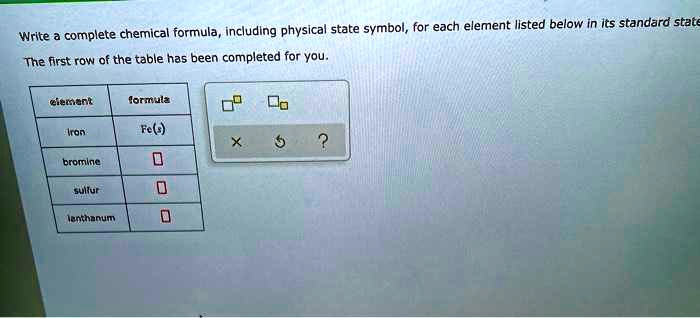Write a complete chemical formula, including physical state symbol, for each element listed below in its standard state The first row of the table has been completed for you. element formula Iron Fe(s) bromine sulfur lanthanum

The Correct Answer and Explanation is:
Here is the completed table with the chemical formulas and physical state symbols for each element in its standard state:
| Element | Formula |
|---|---|
| Iron | Fe(s) |
| Bromine | Br₂(l) |
| Sulfur | S₈(s) |
| Lanthanum | La(s) |
Explanation The standard state of an element refers to the most stable physical form of that element under standard conditions, which are 1 atmosphere of pressure and 25 degrees Celsius. It is important to include the physical state symbol in chemical formulas to indicate whether the substance is a solid (s), liquid (l), or gas (g) under these conditions. This distinction helps predict how substances behave during chemical reactions.
Iron is a metallic element that naturally exists in solid form. Therefore, its standard formula is written as Fe(s). It consists of a vast network of iron atoms held together by metallic bonds, giving it structural strength and conductivity.
Bromine is one of the only nonmetallic elements that exists as a liquid in its standard state. It forms diatomic molecules, meaning two atoms bond together, which is why its formula is Br₂(l). The molecular nature and liquid state make bromine relatively reactive and useful in various chemical applications.
Sulfur typically exists as a bright yellow solid in the form of octatomic molecules. This means each molecule contains eight sulfur atoms arranged in a crown shape, leading to the formula S₈(s). The molecular structure helps explain its low solubility and its use in industrial processes like vulcanization.
Lanthanum is a metallic rare earth element. It is solid under standard conditions and is represented by the symbol La(s). Lanthanum is known for its utility in specialized alloys and high-performance magnets.
Each of these formulas conveys more than just the identity of the element—it communicates structural and thermodynamic information that is essential in both academic and practical chemistry.
